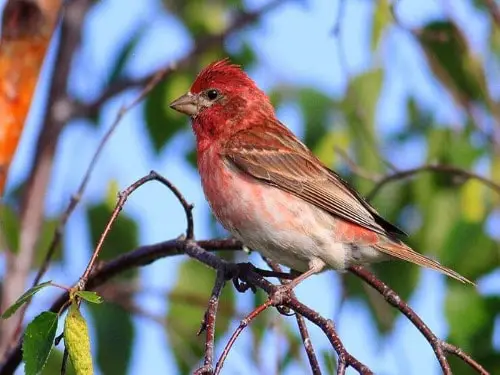Last Updated on: February 5, 2025
Michigan is an ideal home for many bird species. It’s surrounded by multiple great lakes, has extensive forest areas, and is located south of the boreal regions — perfect for birds migrating during winter!
And also…
Some of the most common birds in the state come from the finch family Fringillidae. These are small songbirds that come in various colors and sizes.
There are around eight finches in Michigan, some being permanent residents and others as partial migrants.
We’re here to talk all about them, so read on!
American Goldfinch (Spinus tristis)
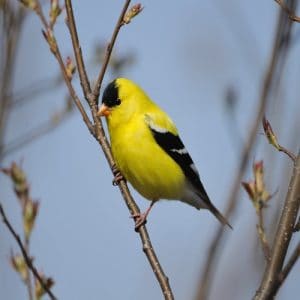
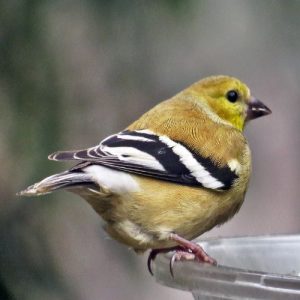
Appearance
The male American Goldfinch (first image) stands out from other finches with its bright yellow feathers on the head, back, shoulder bars, and underparts. This color is contrasted by its black cap and black wings and tail that have white patches.
Meanwhile, the female American Goldfinch (second image) is a duller yellow beneath and olive-green above. It also lacks the black cap. However, both sexes turn slightly brown during winter.
Habitat
American Goldfinches are familiar year-round residents of Michigan. You can typically find them around weedy fields, brushy thickets, roadsides, orchards, and suburban areas. They usually nest in trees, shrubs, or dense weeds.
Diet
American Goldfinches are strict vegetarians that primarily eat seeds, especially those from weeds and grasses. They may also eat buds and bark.
You can best attract them with sunflower or nyjer seeds, although they’re not picky about the seeds they’ll eat. These common birds visit backyard feeders any time of the year, but more frequently during winter.
Fun Fact
The American Goldfinch is the only goldfinch species that molts its feathers twice a year, once in late winter and late summer.
Common Redpoll (Acanthis flammea)
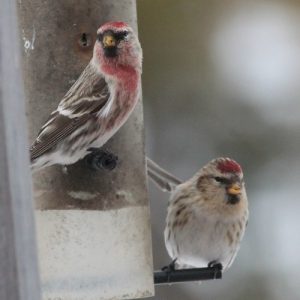
Appearance
The Common Redpoll has dark brown and gray upperparts, while its underparts are white with heavily-streaked sides. Furthermore, it has a prominent red patch on the forehead.
Both sexes have the same colors and patterns, except male Common Redpolls (top) have a frosty red plumage on the chest, while females (bottom) don’t.
Habitat
Despite its name, the Common Redpoll is an uncommon bird in Michigan. This species is only present during winter after migrating from the arctic tundra.
You may find one in coniferous forests, open thickets, and weedy fields. It usually nests close to the ground in dense scrubs, under brush piles, or in grass clumps.
Diet
Common Redpolls primarily feed on seeds throughout the year. However, they may also eat insects during summer. They usually forage in large flocks of up to several hundred birds.
You can attract these winter finches by loading your feeder with tiny seeds like nyjer or shelled sunflower.
Fun Fact
The Common Redpoll may tunnel into the snow during winter nights to stay warm.
House Finch (Haemorhous mexicanus)
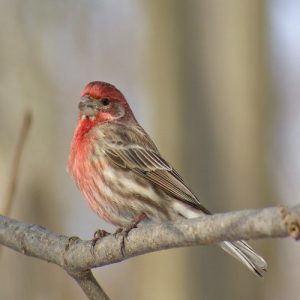

Appearance
The House Finch has streaked brown feathers that are darker above and lighter beneath. It also has a short bill and a long tail that’s slightly notched.
The male finch (first image) has a red wash on the head, throat, and rump, whereas the female (second image) is simply brown overall.
Habitat
House Finches are common and present year-round in Michigan. These birds thrive in various habitats, such as forest edges, deserts, orchards, city parks, buildings, and other places with lawns or weedy areas. However, you won’t find House Finches in unbroken forests.
They also have various nesting sites, both in natural and human-made structures. They may even use abandoned nests of other birds.
Diet
House Finches mostly eat vegetable matter, especially weed seeds. Other parts of their diet include buds and flower parts during spring, small fruits and berries during summer and fall, and small insects like aphids. They usually forage in flocks, except when they’re nesting.
These birds will also visit your seed feeders, especially for black oil sunflower seeds. They may even drink the nectar from your hummingbird feeder.
Fun Fact
The House Finch was originally from Mexico and the western USA. When New York pet shop owners sold these birds illegally, they released them into the wild to avoid getting caught. Since then, they have flourished and become widespread.
Pine Grosbeak (Pinicola enucleator)
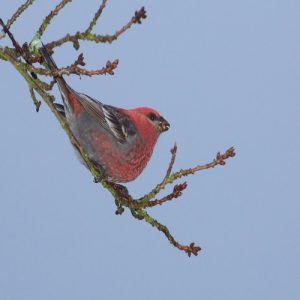

Appearance
The Pine Grosbeak is a large and robust finch with grey feathers on the back and underparts, a black tail, and black wings with some white wing bars. Adult males (first image) have a red wash on the head, back, and chest, whereas adult females (second image) are yellow instead.
Habitat
Pine Grosbeaks are only present in Northern Michigan during winter. They aren’t found anywhere else in the state.
They reside mainly on conifers but often go to deciduous trees during winter. You may also find them on shade trees in residential areas when they look for food.
Despite the name, they don’t usually breed in pine forests. Instead, they do so in other conifers, such as spruce and fir.
Diet
Pine Grosbeaks primarily eat vegetable matter, such as seeds, buds, berries, and wild fruits. During summer, they will occasionally eat insects.
They often appear in groups at backyard feeders, looking for sunflower seeds, fruits, and suet. Since they’re quite large, it’s best to use platform or hopper feeders for them.
Fun Fact
The Pine Grosbeak is known for being relatively tame and slow-moving. Locals in Newfoundland have even called it “mope.”
Pine Siskin (Spinus pinus)
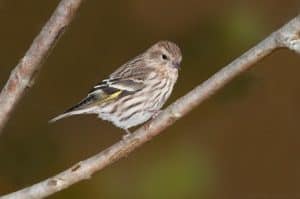
Appearance
The Pine Siskin has streaky brown plumage that’s darker above and lighter beneath. It also has dark wings and notched tails, both having some yellow markings. Unlike other finches, both sexes of this species look the same.
Habitat
Pine Siskins are common and present in northern Michigan year-round, but only in the southern and central regions during winter.
These petite finches prefer living in coniferous and deciduous forests, but they can adapt wherever food is available. You may see them foraging around weedy fields, thickets, suburbs, and gardens. Pine Siskins usually nest in a well-hidden branch of a conifer tree.
Diet
Pine Siskins primarily eat seeds and other vegetable matter, such as buds, parts of flowers, and nectar. However, they also consume insects.
Meanwhile, they can form noisy flocks around your feeders, especially if you offer nyjer seeds or pine seeds.
Fun Fact
The Pine Siskin can ramp up its metabolic rate to increase body temperature. This rate can accelerate up to five times faster during freezing nights.
Purple Finch (Haemorhous purpureus)
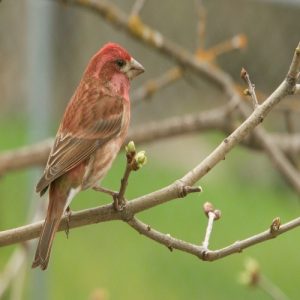
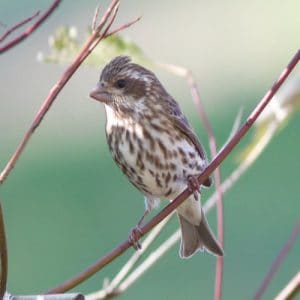
Appearance
The Purple Finch has a brown-streaked back, while its underparts are pale with some thick, faint streaks on the sides. Additionally, it has a slightly spiky crown.
People have described the male finch (first image) as looking like it was dipped in raspberry juice due to the purplish-red wash on its head, back, throat, and belly. However, the female (second image) lacks this feature.
Habitat
Purple Finches reside permanently in northern Michigan, whereas they only visit the southern half of the state during winter.
You can usually find them in coniferous and mixed woods, but they may also visit overgrown fields, shrublands, and suburbs. However, Purple Finches prefer staying in the forest interior during the breeding season.
Diet
Purple Finches typically eat seeds and buds from trees. Other than that, they also consume many small fruits, berries, weed seeds, flower buds, and some insects during the summer. They usually forage in small flocks.
These birds often visit backyard feeders for black oil sunflower seeds. They prefer thinner sunflower seeds over wider ones. You can encourage them even further if you have coniferous trees in your backyard.
Fun Fact
The Purple Finch is one of the few finches in Michigan that demonstrate aggressive behavior toward each other, especially when food is scarce.
Red Crossbill (Loxia curvirostra)
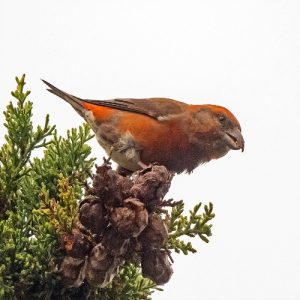

Appearance
The male Red Crossbill (first image) has a pretty simple appearance. It has a red-orange body, dark brown wings and tail, dark legs, and a twisted beak. The female (second image) has a similar pattern, except the body is a dull yellow.
Habitat
Red Crossbills are present throughout Michigan. They’re in the north and central regions of the state all year, whereas they only visit the south of the state during winter.
They’re usually found in coniferous groves and forests, seldom away from conifers. However, some may wander to forest plantations, parks, and towns away from their usual range.
During breeding seasons, Red Crossbills nest in various coniferous trees depending on the region. Whenever they flock, breeding pairs stay close to each other.
Diet
Based on their habitat, Red Crossbills prefer conifer seeds, especially pine. Apart from that, they consume buds of trees, weed seeds, deciduous seeds, berries, and insects.
Unfortunately, they rarely visit bird feeders. If you’re lucky, some might visit you during winter if you offer pine or sunflower seed.
Fun Fact
The Red Crossbill is so dependent on conifers that it can breed anytime (even in winter) so long as there’s a significant cone crop.
White-Winged Crossbill (Loxia leucoptera)
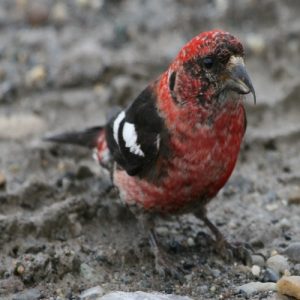
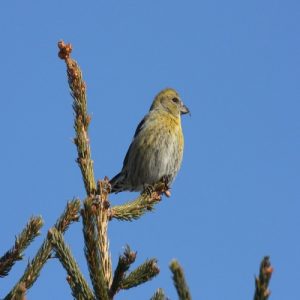
Appearance
The male White-Winged Crossbill (first image) has a bright red body, whereas the female (second image) has a dull, yellow-brown body. However, both sexes have a black tail, black wings with bold white wing bars, and a pale belly.
This species also has the same twisted beak as the Red Crossbill.
Habitat
White-Winged Crossbills are permanent residents of Michigan, but only in the northern and central parts of the state. They are only present in the southern regions during winter. They prefer living in coniferous forests, mainly spruce and tamarack.
During the breeding season, they breed primarily in places with high concentrations of spruce trees. With this, the typical nesting site is on a horizontal limb of a spruce tree.
Diet
White-Winged Crossbills mostly eat conifer seeds. However, they may also feed on buds, weed seeds, berries, and insects. They usually forage in flocks.
These finches don’t usually go to bird feeders but may occasionally visit when food is limited in the wild. You can attract them with various seeds, especially hulled sunflower seeds.
Fun Fact
The White-Winged Crossbill has an unusually-shaped bill that makes it easier to take the seeds from cones. Specifically, the bill separates the cone scales while the tongue removes the seeds.
Watch This!
Frequently Asked Questions
Are finches year-round in Michigan?
Some finches are present in Michigan all year, such as:
- American Goldfinch
- House Finch
- Pine Siskin
- Purple Finch
- Red Crossbill
- White-Winged Crossbill
Meanwhile, other finch species only visit during winter, such as:
- Common Redpoll
- Pine Grosbeak
How do I identify a finch?
The first course of action is to look at their colors. Finches are colorful enough to be easily distinguished from each other.
However, females of certain species can look alike. In that case, you need to look at their structure, such as their body size, bill shape, tail and crown feathers, and so on.
Can I keep a finch as a pet?
Yes, finches are commonly kept as pets since they are social, inexpensive, and low-maintenance. Of course, you should first consider the pros and cons of owning finches before getting one.
Conclusion
As you can see, Michigan is home to many fascinating finch species. Their colorful plumage and social behavior capture the hearts of avid bird watchers and average citizens alike. Even better, these birds are common and widespread throughout the country. You could be taking a walk outside and see a couple of finches foraging for food.
Whether you’re visiting a birding spot or setting up a backyard feeder, we hope this article helped you get closer to the various finches in Michigan!

